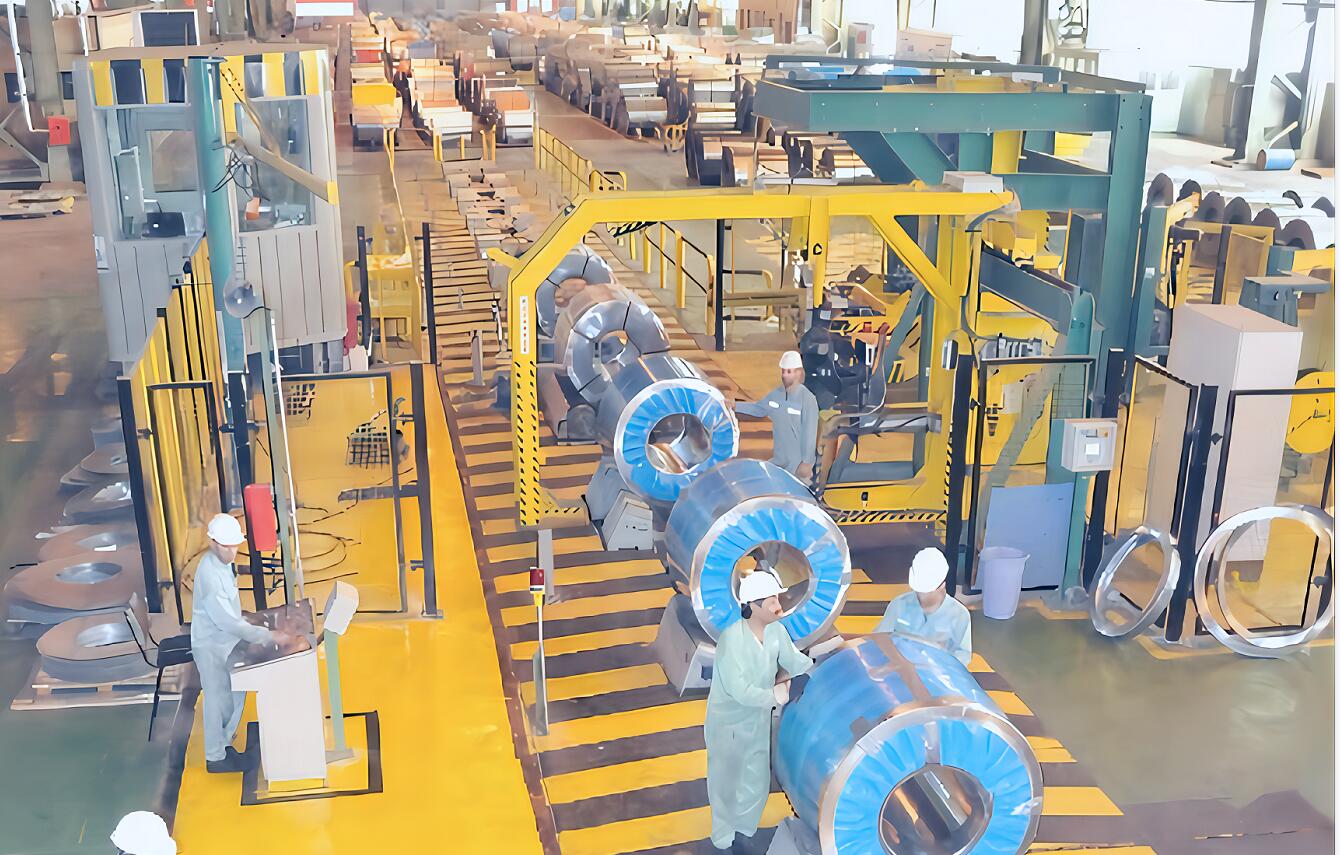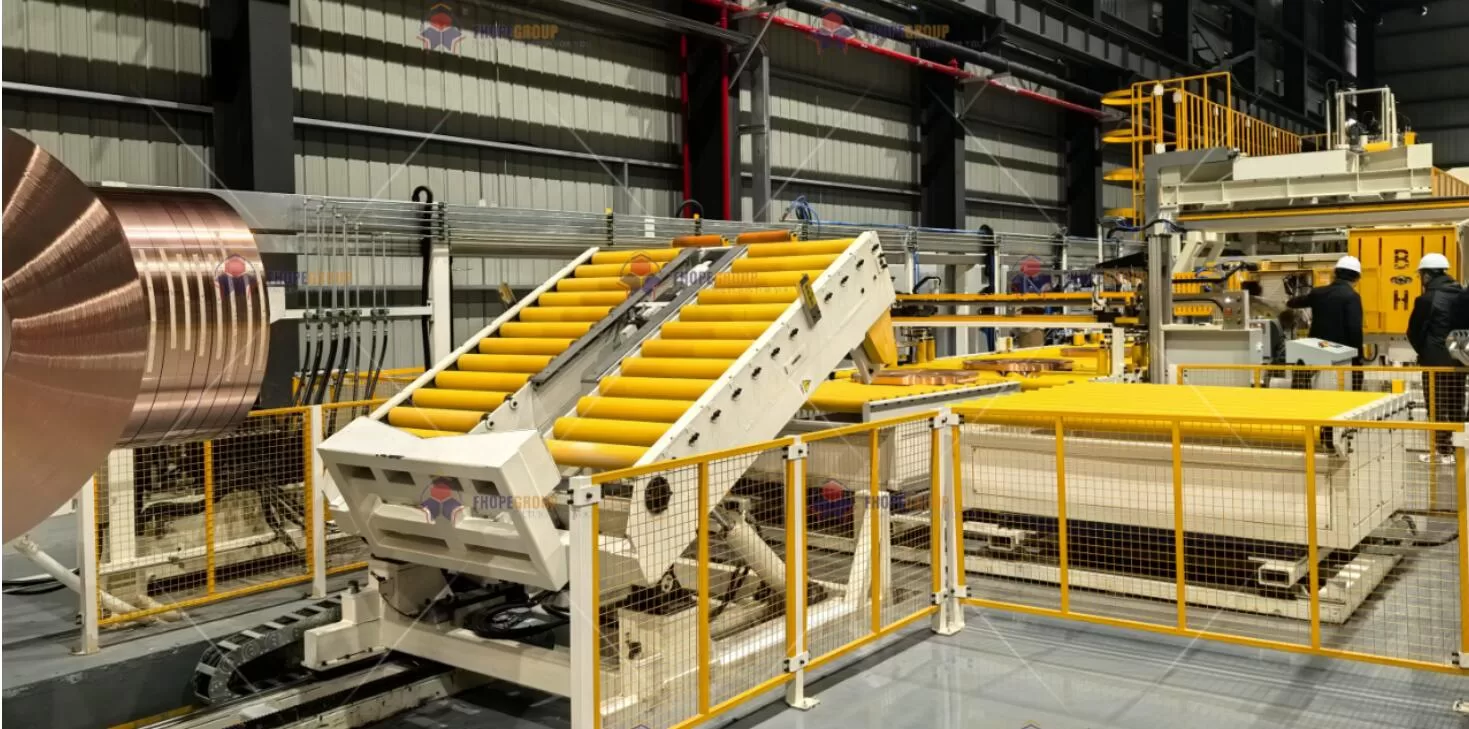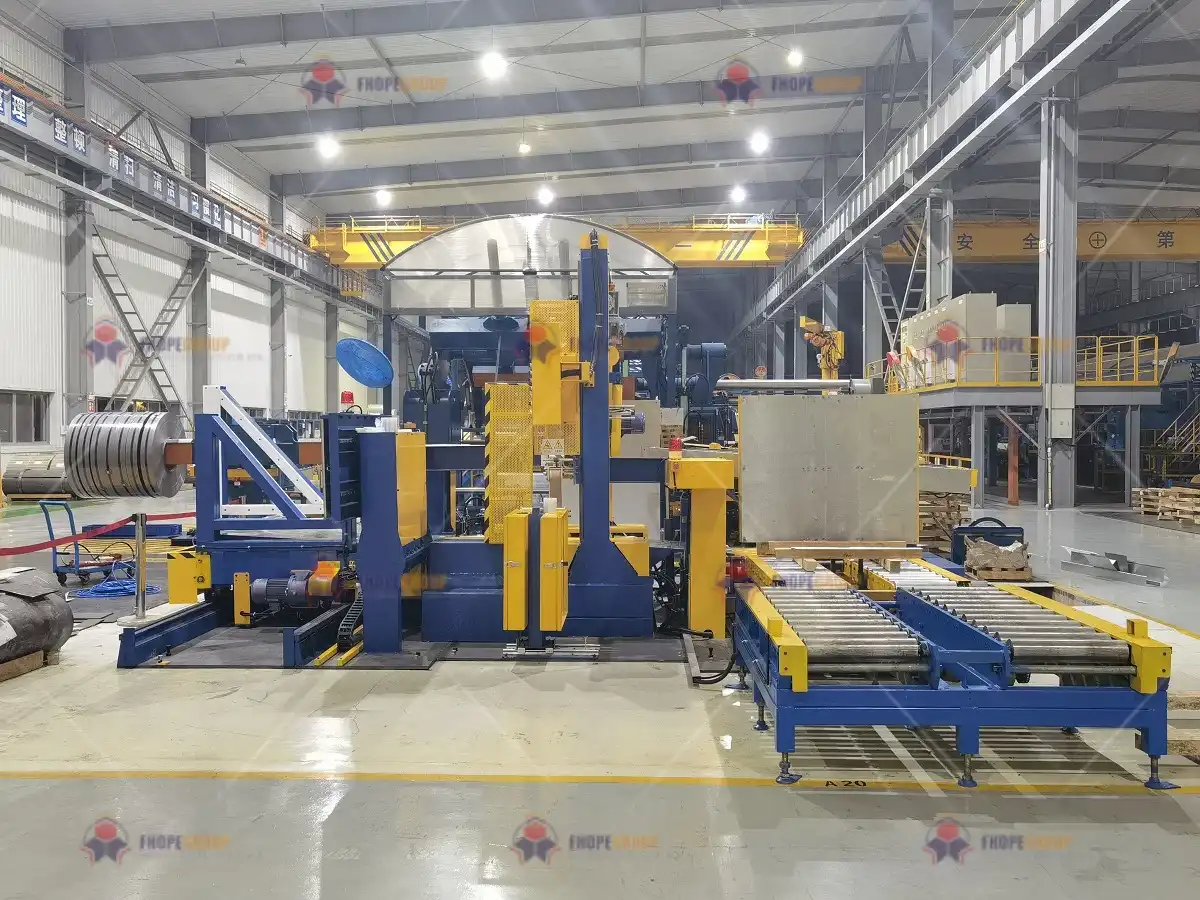Are you running a steel mill and constantly battling equipment failures? Your packaging line is supposed to be the final step, securing your valuable product. But instead, it’s a bottleneck. Downtime from an old, unreliable machine costs you more than just repair bills. It costs you lost production, delayed shipments, and frustrated customers. I’ve seen this story unfold many times. A perfectly good steel coil sits waiting while engineers scramble to fix a broken-down wrapper, and the entire production schedule grinds to a halt. You know there has to be a better way to protect your output and increase your throughput.
The coil packaging lines preferred by Turkish steel mills focus on robust automation, high efficiency, and operational reliability. These systems are designed for high-volume environments, integrating seamlessly with production to minimize bottlenecks. They use durable components and intelligent controls to ensure consistent wrapping quality and high throughput, which are critical for competing in the global steel market.

My journey in this industry began on the factory floor. I was an engineer, just like the ones you probably employ. I saw firsthand how a single point of failure in the packaging area could disrupt the entire plant's efficiency. Later, when I built my own factory, I made a promise to myself. I would only create machines that solve problems, not create new ones. I learned that a packaging line is not just a machine; it's a promise of reliability to your customers. Many Turkish steel producers, who operate in one of the world's most competitive markets, understood this early on. They don't just buy a machine; they invest in a solution that guarantees their product reaches its destination safely and on time. Let’s explore how this approach can transform your operations.
How can a packaging line solve the problem of aging equipment?
Your production lines have been the backbone of your business for over a decade. They've served you well. But now, the signs of aging are impossible to ignore. A sensor fails here, a motor overheats there. Each small breakdown is a fire you have to put out, pulling skilled technicians away from more important tasks. The constant "firefighting" drains resources and morale. This isn't just an inconvenience; it's a direct threat to your output goals and a hidden drain on your profits. The unpredictable nature of these failures makes it impossible to plan with confidence.
A new, modern coil packaging line directly replaces the unreliability of aging equipment with predictable, consistent performance. It is engineered with modern components, advanced diagnostics, and superior materials designed for long-term, heavy-duty use. This shift from a reactive maintenance model to a proactive, stable operation eliminates unplanned downtime, allowing you to meet and exceed your production targets consistently.

When I visit steel mills, I often talk to the maintenance managers. Their stories are always similar. They have a deep understanding of their old machines, but they're fighting a losing battle. The spare parts are becoming harder to find, and the original manufacturers may not even exist anymore. They are forced to custom-fabricate parts, which is both time-consuming and expensive. This is a classic challenge for a seasoned business owner like Javier. You value the longevity of your investments, but there comes a point where the cost of holding on outweighs the cost of upgrading.
The Hidden Costs of Old Equipment
The most obvious cost of an old machine is the repair bill. But the true costs are often hidden. Unplanned downtime stops your entire production flow. If your slitting line produces 10 coils per hour, and your packaging line is down for 3 hours, that's 30 coils that are not shipped. This creates a backlog that impacts your entire operation. Furthermore, older machines often lack the safety features of modern equipment, posing a greater risk to your employees. This is a liability that no business can afford to overlook. A new line isn't just about speed; it's about creating a safer, more predictable work environment.
A Shift to Proactive Operations
A new SHJLPACK line is designed for reliability. We use components from world-class brands like Siemens and Schneider. This means parts are readily available, and performance is guaranteed. Our systems also come with advanced diagnostic tools. Instead of guessing what's wrong, your technicians can pinpoint the issue immediately through the HMI (Human-Machine Interface). The system can even alert you to potential issues before they become critical failures. This enables predictive maintenance, a key goal for any modern steel mill aiming for 95% uptime. You are no longer reacting to problems; you are preventing them.
Let's compare the operational reality of an old line versus a new one.
| Feature | Typical 15+ Year Old Line | New SHJLPACK Line | Impact on Throughput |
|---|---|---|---|
| Downtime | Frequent, unpredictable failures | Minimal, scheduled maintenance | Drastic reduction in production stoppages |
| Maintenance | Reactive, "firefighting" | Proactive, predictive | Frees up engineering resources for optimization |
| Spare Parts | Hard to source, often custom | Standardized, readily available | Reduced repair times from days to hours |
| Safety | Outdated standards, higher risk | Compliant with modern safety regulations | Lower risk of accidents and related costs |
| Data & Diagnostics | None or very limited | Integrated HMI with fault logs | Fast troubleshooting, data for process improvement |
Investing in a new packaging line is not just about replacing a machine. It's about upgrading your entire operational philosophy. It's a strategic move away from uncertainty and towards controlled, efficient, and higher-throughput production.
Can a new packaging line really lower my energy costs?
Energy prices are a constant concern. You watch the markets for electricity and fuel, knowing that every fluctuation directly impacts your bottom line. Your older equipment was built in an era when energy was cheaper and environmental concerns were lower. These machines are often energy hogs, with oversized motors and inefficient hydraulic systems that run continuously, whether they are processing a coil or not. You've already made smart investments in areas like waste heat recovery. But you suspect there are still significant savings to be found, especially in ancillary equipment like your packaging line.
Yes, a modern coil packaging line can significantly lower your energy costs. By using high-efficiency servo motors instead of traditional hydraulics, implementing smart "sleep" modes during idle times, and optimizing the wrapping process to use less power per cycle, a new line can reduce its energy consumption by 30-50% compared to older models. This provides a direct and measurable reduction in your plant's overall energy bill.

I remember a project we did for a Turkish steel exporter. Their primary challenge was cost competitiveness. To compete in the European market, they had to control every penny. Their CEO pointed to his old packaging machine and said, "Vincent, that machine runs all day, but it only works for a few minutes every hour. The rest of the time, it's just burning electricity." He was absolutely right. Old hydraulic power packs often run constantly to maintain pressure. This is incredibly wasteful. It's like leaving your car engine running while you're parked. It was this insight that pushed us to focus heavily on energy efficiency in our designs. We knew that for clients like him, and for forward-thinking owners like Javier, reducing operational costs is a key part of long-term strategy.
Targeted Energy Savings in Modern Design
A modern packaging line is engineered from the ground up to be energy-efficient. It’s not an afterthought; it’s a core design principle. Here are the specific areas where we achieve these savings:
1. The Shift from Hydraulics to Servos
Older packaging systems heavily rely on hydraulic power to move heavy coils and operate wrapping mechanisms. Hydraulic systems are powerful, but they are notoriously inefficient. The pump often runs continuously, and a lot of energy is lost as heat. Our new-generation lines use high-efficiency electric servo motors for key movements. Servos only consume significant power when they are actually moving. During idle periods, their energy consumption is near zero. This "power-on-demand" approach is a game-changer for reducing baseline energy use.
2. Intelligent Power Management
Our control systems are programmed with intelligent power management. If the line doesn't receive a coil for a set period (e.g., 5 minutes), it automatically enters a low-power "sleep" mode. Conveyors, wrappers, and other components shut down until a new coil is detected. This simple feature can lead to substantial savings over a 24-hour production cycle, especially in operations where the flow of coils is not continuous.
3. Optimized Mechanical Design
Efficiency isn't just about motors. It's also about smart mechanical design. We use lightweight, high-strength materials for the wrapping ring, which reduces the inertia and the power needed to rotate it at high speeds. We've also optimized the gear systems and bearings to minimize friction. Each of these small improvements adds up to a lower overall power requirement for the machine.
Here's a breakdown of the energy impact:
| Component | Old Hydraulic System | Modern Servo-Electric System | Estimated Energy Reduction |
|---|---|---|---|
| Main Drive | Constantly running hydraulic pump | Servo motor (power on demand) | 40-60% |
| Conveyors | Standard AC motors, run continuously | High-efficiency motors with auto-off | 20-30% |
| Idle State | High baseline power consumption | Low-power sleep mode | >90% |
| Overall System | High energy waste as heat | Minimal heat loss, efficient power use | 30-50% overall |
By targeting these areas, a new packaging line becomes more than just a production tool. It becomes an active contributor to your goal of reducing unit energy consumption. It’s a direct investment in lowering your operational costs and improving your environmental footprint.
What makes a packaging solution a strategic asset, not just a cost center?
You view every major purchase through the lens of ROI. A machine is not just a piece of metal; it’s an investment that must generate a return. Too often, equipment is treated as a simple cost center—an unavoidable expense required for production. But you're looking for more. You need partners who understand your business and can provide solutions that add value beyond their basic function. You want an asset that strengthens your market position, improves quality, and supports your long-term growth strategy.
A packaging solution becomes a strategic asset when it moves beyond simply wrapping coils and starts contributing to core business goals. This happens when the solution guarantees product integrity, enhances your brand's reputation for quality, provides valuable production data, and comes with a partnership that offers full-process support—from design to long-term optimization. It transitions from an operational expense to a value-creation engine.

When I started SHJLPACK, my slogan "TOTAL SOLUTION FOR WRAPPING MACHINE" was born from my experience as an engineer and a factory owner. I knew that just selling a machine wasn't enough. A client in Mexico, much like Javier, once told me, "Vincent, I can buy a machine from anyone. I need to buy success from someone." That statement has guided my company's philosophy ever since. A strategic asset doesn't just perform a task. It protects your revenue, enhances your brand, and makes your entire operation stronger. Your steel coils are a high-value product. The final packaging is the last thing you do to protect that value before it reaches your customer. A failure at this stage can tarnish a reputation built over years.
From Machine Supplier to Strategic Partner
A supplier sells you a machine. A partner helps you succeed with it. This is the fundamental difference. Our approach is built on a partnership model that covers the entire lifecycle of the equipment. We don't disappear after the sale is complete.
Here are the stages of our partnership:
| Partnership Stage | Our Activity | Your Benefit (The Strategic Value) |
|---|---|---|
| 1. Consultation & Design | We analyze your layout, coil sizes, and throughput needs. We design a custom layout. | A solution optimized for your specific space and workflow, not a one-size-fits-all machine. |
| 2. Manufacturing & Testing | We build your line and conduct a full test run with your coil specifications in our factory. | You receive a proven, de-bugged system, minimizing installation surprises and delays. |
| 3. Installation & Training | Our engineers supervise installation and provide comprehensive training for your operators and maintenance staff. | Your team becomes self-sufficient quickly, ensuring smooth operation and proper maintenance from day one. |
| 4. Long-Term Support | We provide ongoing technical support, readily available spare parts, and advice on future upgrades or optimizations. | Peace of mind. You have an expert resource on call, ensuring the asset continues to deliver value for years. |
The Packaging as a Brand Ambassador
Think about how your customer receives your product. A perfectly wound, clean, and securely packaged coil sends a powerful message. It says you care about quality, down to the last detail. In contrast, a coil that arrives damaged due to poor packaging suggests carelessness. In competitive markets, this can be the difference between a repeat order and a lost customer. A reliable, high-quality packaging line ensures that your product arrives in perfect condition, every time. It turns your packaging into a silent ambassador for your brand's commitment to excellence. This brand protection is an intangible but incredibly valuable return on your investment. It elevates the packaging line from a mere machine to a guardian of your reputation.
How does an automated packaging line support digitalization and reduce labor costs?
You have a clear vision for a digital future. You want to see your entire production process on a single dashboard, using data to make smarter decisions, predict failures, and optimize schedules. At the same time, you face the universal challenge of managing labor costs and availability. Finding, training, and retaining skilled labor is difficult. You need solutions that reduce manual intervention, improve safety, and seamlessly integrate into your digital ecosystem. An isolated, "dumb" machine has no place in your forward-looking strategy.
An automated coil packaging line directly supports digitalization by providing a rich stream of operational data that can be fed into MES and IoT platforms. It simultaneously reduces labor costs by automating repetitive and physically demanding tasks like coil placement, wrapping, and labeling. This frees up your workforce for higher-value activities and creates a safer, more efficient, and data-driven packaging process.

In the early days of my career, coil packaging was an almost entirely manual process. It was slow, inconsistent, and dangerous. I've seen workers struggle to handle heavy packing materials and maneuver around moving equipment. When I founded my own factory, automation was my top priority, not just for efficiency, but for the well-being of the employees. Today, this focus has evolved. Automation is no longer just about replacing manual labor; it's about creating intelligent systems. A modern packaging line is a node in your factory's information network. It should talk to your other systems. For a leader like Javier, who has already implemented a smart scheduling platform, the next logical step is to ensure every key piece of equipment, including the packaging line, can provide the data needed to make that platform even smarter.
The Data-Driven Packaging Cell
A modern automated line is equipped with a host of sensors and a powerful PLC (Programmable Logic Controller). It's not a black box; it's a source of valuable intelligence. This data is the foundation of your digital transformation goals.
Key Data Points and Their Uses:
| Data Provided by the Line | How It Supports Your Goals |
|---|---|
| Cycle Time per Coil | Feeds directly into your OEE (Overall Equipment Effectiveness) calculations. Helps identify bottlenecks and measure throughput accurately. |
| Material Consumption | Tracks the exact amount of stretch film or paper used per coil. Allows for precise cost control and inventory management. |
| Fault Codes & Alarms | Provides specific diagnostic information when a fault occurs. This is critical for predictive maintenance and rapid troubleshooting. |
| Coil ID (from Barcode/RFID) | Associates all packaging data with a specific coil, creating a complete production history for quality control and traceability. |
| Operational Status | Real-time status (running, idle, fault) can be visualized on your plant-wide MES dashboard. |
This data integration allows you to achieve true production visibility. You can see how your packaging performance impacts overall plant efficiency and make informed decisions to optimize the entire process, from slitting to shipping.
Automation's Impact on Labor and Safety
Automating the packaging process delivers clear, immediate benefits. The system can automatically receive a coil from a turnstile or walking beam, center it, lift it, wrap it according to a pre-set program, and then discharge it to the next station. This removes the need for operators to be in close proximity to heavy, moving machinery, drastically improving safety. It also eliminates the manual, repetitive tasks that can lead to strain injuries. By automating these steps, you can re-allocate your valuable human resources to tasks that require critical thinking, such as quality oversight, system monitoring, and process improvement. This not only reduces direct labor costs but also elevates the roles of your employees, making their work safer and more engaging.
Conclusion
Upgrading your coil packaging line is a strategic investment in higher throughput, lower costs, and future-readiness. It is a direct path to achieving greater operational stability and efficiency.




